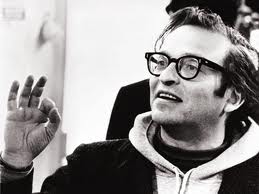By Stanley Corkin
Sidney Lumet never won an academy award and was rarely placed in the company of the elite Hollywood directors, like Martin Scorsese and Francis Coppola. Yet, his body of work suggests the need for a re-evaluation. I have long appreciated Lumet’s mastery of his craft and particularly his ability to use New York’s urban landscape as a character in his films. But it was while working on my book Starring New York: Filming the Grime and Glamour of the Long 1970s that I gave him the attention that deepened my regard. Serpico (1973), and Dog Day Afternoon (1975) Prince of the City (1981), are prominently featured in my study, as is to a lesser degree, Network (1976). In these films, as in so many others—The Pawnbroker (1964), Daniel (1980), The Verdict (1982), Q and A (1990)—Lumet shows his mastery of his craft, directing not with flash, but with a deep regard for his material. He never brings undue attention to his style; rather, in every shot he complicates our understanding of his characters and their complex relationships to each other and the world. I came to see that his vision of New York in the great films he directed in the 1970s was complexly historical and anthropological. In Network, the exterior shots of corporate headquarters of the various television networks say everything about the remoteness and shallow calculations of those businesses, and how they are definitional for a sector of New York City. His montage that begins Dog Day Afternoon is an amazing short film in itself, tracking the geographic and social complexity of New York, as well as its points of contact—water, air, electronic—with a world beyond. Lumet truly understood his city as it morphed into its post-modern incarnation, a city of uneven economic development, deeply involved in the moment of globalized trade and culture.
But it was while working on my book Starring New York: Filming the Grime and Glamour of the Long 1970s that I gave him the attention that deepened my regard. Serpico (1973), and Dog Day Afternoon (1975) Prince of the City (1981), are prominently featured in my study, as is to a lesser degree, Network (1976). In these films, as in so many others—The Pawnbroker (1964), Daniel (1980), The Verdict (1982), Q and A (1990)—Lumet shows his mastery of his craft, directing not with flash, but with a deep regard for his material. He never brings undue attention to his style; rather, in every shot he complicates our understanding of his characters and their complex relationships to each other and the world. I came to see that his vision of New York in the great films he directed in the 1970s was complexly historical and anthropological. In Network, the exterior shots of corporate headquarters of the various television networks say everything about the remoteness and shallow calculations of those businesses, and how they are definitional for a sector of New York City. His montage that begins Dog Day Afternoon is an amazing short film in itself, tracking the geographic and social complexity of New York, as well as its points of contact—water, air, electronic—with a world beyond. Lumet truly understood his city as it morphed into its post-modern incarnation, a city of uneven economic development, deeply involved in the moment of globalized trade and culture.
Stanley Corkin is Professor of English at the University of Cincinnati and author of Starring New York: Filming the Grime and the Glamour of the Long 1970s.


